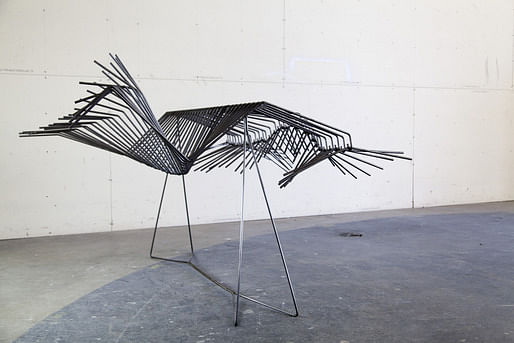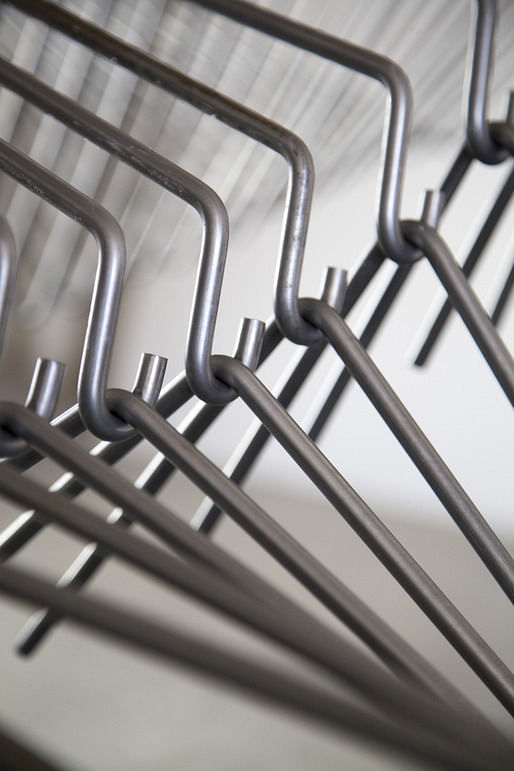
This last semester at the University of Michigan, Taubman College hosted a workshop with Brandon Clifford and Daniel Piker called, “ROBOTIC GRAVITY.” The workshop took place at Taubman College and lasted three days with the participation of students in the M.Arch and M.S. Arch.
_____________________________________________________________________

Brandon Clifford
Brandon Clifford is currently the Belluschi Lecturer at the Massachusetts Institute of Technology as well as Principal at Matter Design, which he co-founded with Wes McGee. Brandon received his Master of Architecture from Princeton University in 2011 and his Bachelor of Science in Architecture from the Georgia Tech in 2006. From 2006-2009 he worked as project manager at Office dA in both Boston and New York where his contributions varied in scale and program—silverware, installations, restaurants, a professional soccer stadium, and numerous urban planning studies. Brandon also served as editor of Pidgin Magazine from 2009-2011, the 2011-2012 LeFevre Emerging Practitioner Fellow at The Ohio State University Knowlton School of Architecture, and the founder of the Malleablist Movement in architecture.
Daniel Piker
Daniel Piker is a researcher on the use of computation for design and realization of complex forms and structures. After studying architecture at the AA, he has worked as part of the Advanced Geometry Unit at Arup, and currently for the Specialist Modelling Group at Foster+Partners. He has taught numerous studios and workshops (including the AADRL, and 2 clusters at SmartGeometry) and presented his work at conferences around the world. He is the creator of the widely used form-finding physics engine ‘Kangaroo’, software which he continues to develop.

There is a great deal of speculation surrounding the artifacts created by our megalithic era ancestors. Much of this is a result of marvel, wonder, intrigue, and most importantly ignorance. When one entertains that these civilizations held a focused knowledge surrounding gravity, mass, and volume (topics we have since lost) these marvels transform from curious speculations into potentials for productive knowledge. The workshop siphons the potentials and method of thinking and conflating it with the technology of our own time. With the aid of computation, architects are now capable of merging physics information into the design process. We are also blurring the line between thinker and maker. The workshop will obtain control over the center of mass by increasing and decreasing the density of mass through robotic fabrication processes. The deliverable of the workshop will be to construct a large-scale artifact that defies the perception of gravity through the principle aid of computation.
Students who participated in the workshop gave their feedback on the experience:
“Daniel Piker, the creator of Kangaroo, introduced the new interface called "Joey", which will supersede Kangaroo. He reworked the way Kangaroo processes information, making it a more powerful design tool simulating natural phenomena. Daniel introduced the new tools and provided some example scripts to begin tinkering. The workshop utilized Joey's center of mass tool to locate the center of mass of complex geometries. After working in small groups to develop several concepts, we came together to produce one complex surface combining Joey and robotic rod bending, a process developed by Wes McGee and Brandon Clifford. The surface was composed of rods carefully balanced on a central frame creating a balancing act between form and gravity. Each rod was counter balanced with another rod of a unique length specific to that rods necessary counter weight.”
Adam Rosekelly, M.S. 2015

“I thought the workshop was a great introduction to Kangaroo, a program which I had never experimented with before. The goal for the workshop was to design and fabricate a balancing structure. We kicked off the workshop with discussion of kinetics, motion and balance and an introductory tutorial for Kangaroo and Joey, a new version of Kangaroo which has real time feedback. We split into small groups and worked on components of the design: connections, kinetics, balance and fabrication. I thought the small groups working on individual components of the project was a good way to really investigate a system in depth in a short period of time.
The following day we worked on individual designs and continued to work in Kangaroo and Joey. Several students produced their designs with the rod bending tools. I worked on a hook system which when pushed, slide a separate component into a slot and self-balanced. These tests were quick explorations and iterations with a lot of freedom for mistakes, unlike many final projects in traditional studio settings.
Based on the small group discussions, a larger design was developed. We moved into fabrication as a group - students tested and generated code for the robotic rod bending process, finished the rods and assembled the components. This entire process was a great exercise in project management and production planning.
I general, I think the short workshops are a great way to problem solve outside of our studio projects. We can become overwhelmed and consumed by the specificity and complexity of our longer term project work. Realizing that we learn to problem-solve through many different experiences and that solutions can translate and apply to many unique situations is crucial to design. Plus it was a great opportunity to work with not only Wes, who is involved in our thesis group, but also tap into Daniel Piker and Brandon Clifford's amazing computation and design knowledge! “
Jayme Van Oot, M.Arch 2015
"There is no better way to learn a new software or fabrication technique, than to produce an artifact as a result of an intense weekend charrette. Robotic Gravity wasn't my first workshop as a Taubman College student, but it was probably the most beneficial. I immediately used my new skills in Kangaroo during my externship in Boston, producing a parametric dynamic model for an upcoming exhibition."
Dustin Brugmann, M.Arch 2015

Sharing insights from Taubman College of Architecture and Urban Planning at the University of Michigan.



No Comments
Block this user
Are you sure you want to block this user and hide all related comments throughout the site?
Archinect
This is your first comment on Archinect. Your comment will be visible once approved.